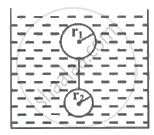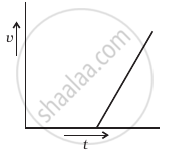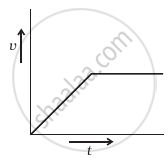Advertisements
Advertisements
Question
A tall cylinder is filled with viscous oil. A round pebble is dropped from the top with zero initial velocity. From the plot shown in figure, indicate the one that represents the velocity (v) of the pebble as a function of time (t).
Options
Solution

Explanation:
In fluids, when the pebble is dropped from the top of a tall cylinder filled with viscous oil, a variable force called viscous force will act which increases with an increase in speed. And at equilibrium this velocity becomes constant, that constant velocity is called terminal velocity.
When the pebble is falling through the viscous oil, the viscous force is F = 6πηrv
Where r is the radius of the pebble, v is instantaneous speed, η is the coefficient of viscosity. As the force is variable, hence acceleration is also variable so the v-t graph will not be a straight line. First velocity increases and then becomes constant known as terminal velocity.
APPEARS IN
RELATED QUESTIONS
A solid sphere falls with a terminal velocity of 20 m s−1 in air. If it is allowed to fall in vacuum,
A solid sphere moves at a terminal velocity of 20 m s−1 in air at a place where g = 9.8 m s−2. The sphere is taken in a gravity-free hall having air at the same pressure and pushed down at a speed of 20 m s−1.
(a) Its initial acceleration will be 9.8 m s−2 downward.
(b) It initial acceleration will be 9.8 m s−2 upward.
(c) The magnitude of acceleration will decrease as the time passes.
(d) It will eventually stop
Two spheres of equal masses but radii r1 and r2 are allowed to fall in a liquid of infinite column. The ratio of their terminal velocities are ____________.
A drop of radius 1.5 x 10-5 and density 2 x 103 kg/m3 falls through air. The viscosity of air is 1.8 x 10-5 N s/m2. Neglecting buoyancy due to air, the terminal speed of the drop is ____________.
A drop of radius 4 x 10-5 m and density 2.5 x 103 kg/m3 falls through air. The viscosity of air is 1.96 x 10-5 N s/m2 . Neglecting buoyancy due to air, the terminal speed of the drop is ____________.
Eight identical drops of water falling through air with uniform velocity of 10 cm/s combine to form a single drop of big size, then terminal velocity of the big drop will be ______.
The radii of the two spheres P and Q of same material falling in the viscous liquid are in the ratio 3 : 2, their terminal velocities (P to Q) are in the ratio ______.
A small spherical ball of radius 0.1 mm and density 104 kg m-3 falls freely under gravity through a distance of h before entering a tank of water. If, after entering the water the velocity of the ball does not change and it continues to fall with the same constant velocity inside the water, then the value of h will be ______ m.
(Given g = 10 ms-2, the viscosity of water = 1.0 × 10-5 N-sm-2).
Two solid spherical balls of radius r1 and r2 (r2 < r1), of density σ are tied up with a long string and released in a viscous liquid column of lesser density ρ and coefficient of viscosity η, with the string just taut as shown. The terminal velocity of spheres is ______.

Two equal drops of water are falling through air with a steady velocity v. If the drops coalesce, the new velocity will be ______.



